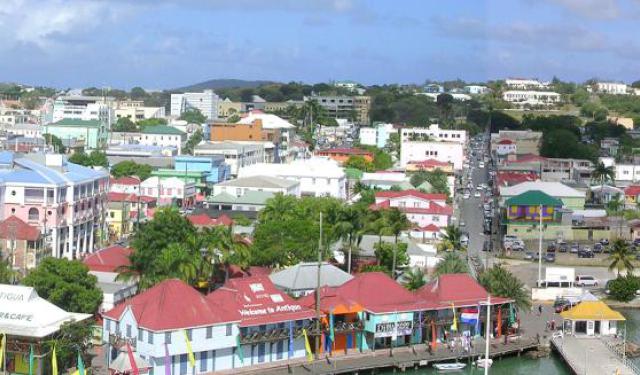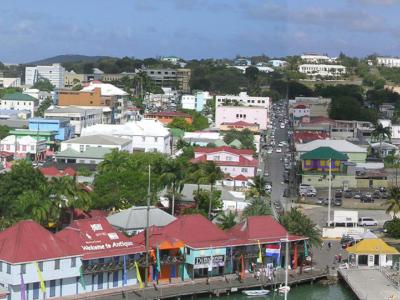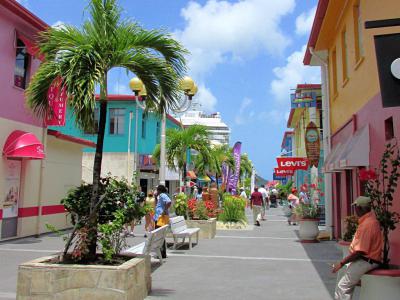
St. John's Introduction Walking Tour (Self Guided), St. John`s
The capital of Antigua and Barbuda, Saint John’s doubles as the nation's primary port. Given its size (the largest city on the island) and the variety of attractions available, it is a favorite stop for Caribbean island-hopping cruises.
Saint John's is named for the island's patron saint and has a storied past deeply rooted in indigenous cultures (the Arawaks and Caribs) and influenced by European colonizers and African slaves.
European colonization and diseases devastated the native population, but the former also led to the rise of lucrative sugar plantations, shaping the island's economy. Saint John's was founded by English settlers in 1632 and in 1667 became the administrative center of the English possessions in Antigua and Barbuda. Its strategic importance in the 18th century, as the British Navy's Caribbean headquarters, brought development to the area.
By the mid-18th century, the city already had a fairly evolved industry, focused on the processing of sugar cane. To work on plantations and factories, African slaves were imported. Following the abolition of slavery in 1834, their descendants remained on the island and today make up the bulk of the local population.
From 1958 to 1962, Saint John's was part of the West Indies Federation, and then of an associated state with Great Britain. In 1981, after Antigua and Barbuda gained independence, Saint John's became the new nation's capital.
Despite numerous disasters, such as earthquakes, a fire, and hurricanes that hit the city throughout its history, Saint John’s remains a sensory delight for visitors, with its vibrant colonial-style architecture adorning the landscape and lively weekly markets showcasing local vendors selling an abundance of fresh produce.
One of the hallmark attractions here is Redcliffe Quay, a picturesque waterfront area lined with colorful buildings from the 17th and 18th centuries. Presently, it is a bustling hub for shopping, dining, and entertainment.
Adjacent to Redcliffe Quay is Heritage Quay, another popular destination for shopping and leisure. Here, visitors can explore a variety of duty-free shops, boutiques, and restaurants, all set against the backdrop of the Caribbean Sea.
Dominating the city's skyline are the majestic Baroque-style white towers of Saint John's Cathedral. Built in the 19th century, this temple is the third on this site after two of its predecessors were destroyed by earthquakes.
Whenever you're out there cruising the Caribbean, make some time to visit Saint John's. Dive into its vibrant atmosphere by visiting the places featured in this self-guided walk and discover the magic of Antigua!
Saint John's is named for the island's patron saint and has a storied past deeply rooted in indigenous cultures (the Arawaks and Caribs) and influenced by European colonizers and African slaves.
European colonization and diseases devastated the native population, but the former also led to the rise of lucrative sugar plantations, shaping the island's economy. Saint John's was founded by English settlers in 1632 and in 1667 became the administrative center of the English possessions in Antigua and Barbuda. Its strategic importance in the 18th century, as the British Navy's Caribbean headquarters, brought development to the area.
By the mid-18th century, the city already had a fairly evolved industry, focused on the processing of sugar cane. To work on plantations and factories, African slaves were imported. Following the abolition of slavery in 1834, their descendants remained on the island and today make up the bulk of the local population.
From 1958 to 1962, Saint John's was part of the West Indies Federation, and then of an associated state with Great Britain. In 1981, after Antigua and Barbuda gained independence, Saint John's became the new nation's capital.
Despite numerous disasters, such as earthquakes, a fire, and hurricanes that hit the city throughout its history, Saint John’s remains a sensory delight for visitors, with its vibrant colonial-style architecture adorning the landscape and lively weekly markets showcasing local vendors selling an abundance of fresh produce.
One of the hallmark attractions here is Redcliffe Quay, a picturesque waterfront area lined with colorful buildings from the 17th and 18th centuries. Presently, it is a bustling hub for shopping, dining, and entertainment.
Adjacent to Redcliffe Quay is Heritage Quay, another popular destination for shopping and leisure. Here, visitors can explore a variety of duty-free shops, boutiques, and restaurants, all set against the backdrop of the Caribbean Sea.
Dominating the city's skyline are the majestic Baroque-style white towers of Saint John's Cathedral. Built in the 19th century, this temple is the third on this site after two of its predecessors were destroyed by earthquakes.
Whenever you're out there cruising the Caribbean, make some time to visit Saint John's. Dive into its vibrant atmosphere by visiting the places featured in this self-guided walk and discover the magic of Antigua!
How it works: Download the app "GPSmyCity: Walks in 1K+ Cities" from Apple App Store or Google Play Store to your mobile phone or tablet. The app turns your mobile device into a personal tour guide and its built-in GPS navigation functions guide you from one tour stop to next. The app works offline, so no data plan is needed when traveling abroad.
St. John's Introduction Walking Tour Map






Guide Name: St. John's Introduction Walking Tour
Guide Location: Antigua and Barbuda » St. John`s (See other walking tours in St. John`s)
Guide Type: Self-guided Walking Tour (Sightseeing)
# of Attractions: 5
Tour Duration: 1 Hour(s)
Travel Distance: 1.3 Km or 0.8 Miles
Author: nataly
Sight(s) Featured in This Guide:
Guide Location: Antigua and Barbuda » St. John`s (See other walking tours in St. John`s)
Guide Type: Self-guided Walking Tour (Sightseeing)
# of Attractions: 5
Tour Duration: 1 Hour(s)
Travel Distance: 1.3 Km or 0.8 Miles
Author: nataly
Sight(s) Featured in This Guide:
- Redcliffe Quay
- Heritage Quay
- Museum of Antigua and Barbuda
- St. John's Cathedral
- Government House
1) Redcliffe Quay (must see)
Nestled overlooking the picturesque harbor of St. John's, Redcliffe Quay boasts a legacy dating back to the 17th and 18th centuries, when it served as a bustling waterfront docking area and the bustling business and trading center of the Caribbean.
In its early days, Redcliffe Quay played a crucial role in the trade of commodities such as slaves, rum, sugar, and coffee between Antigua, Europe, and Africa. It stood witness to the ebb and flow of maritime commerce, establishing itself as a vital hub in the vibrant tapestry of Caribbean trade. Today, the quay has transformed into a tranquil and shaded oasis, providing respite from the heat and activity of St. John's.
From Redcliffe Quay, visitors can enjoy panoramic views of the sea, watching yachts and boats gracefully navigating the harbor or marveling at the colossal cruise ships that frequent the island during the season. The quay has become a haven of peace, inviting exploration through its various courtyards and boardwalks.
As visitors meander through the cobblestone paths, they will encounter a treasure trove of unique and beautiful boutiques. These establishments showcase an array of locally made gifts, including pottery, paintings, jewelry, clothes, shoes, and accessories. Each boutique adds a distinctive touch to the quay, creating a vibrant tapestry of local craftsmanship and creativity.
In its early days, Redcliffe Quay played a crucial role in the trade of commodities such as slaves, rum, sugar, and coffee between Antigua, Europe, and Africa. It stood witness to the ebb and flow of maritime commerce, establishing itself as a vital hub in the vibrant tapestry of Caribbean trade. Today, the quay has transformed into a tranquil and shaded oasis, providing respite from the heat and activity of St. John's.
From Redcliffe Quay, visitors can enjoy panoramic views of the sea, watching yachts and boats gracefully navigating the harbor or marveling at the colossal cruise ships that frequent the island during the season. The quay has become a haven of peace, inviting exploration through its various courtyards and boardwalks.
As visitors meander through the cobblestone paths, they will encounter a treasure trove of unique and beautiful boutiques. These establishments showcase an array of locally made gifts, including pottery, paintings, jewelry, clothes, shoes, and accessories. Each boutique adds a distinctive touch to the quay, creating a vibrant tapestry of local craftsmanship and creativity.
2) Heritage Quay (must see)
Heritage Quay, a vibrant shopping enclave located in the heart of the capital St. John's, stands as a bustling urban gem that overlooks the picturesque harbor. Nestled amid historic buildings and traditional architecture, Heritage Quay is renowned for offering an impressive array of duty-free items, making it one of the most prestigious shopping complexes in the Caribbean.
The layout of Heritage Quay is attractively designed, situated right on the waterfront to provide visitors with a captivating shopping experience. This urban shopping haven is synonymous with duty-free indulgence, offering a diverse selection of items that cater to a wide range of tastes and preferences. From spirits and fragrances to artwork, leather goods, china, crystal, designer labels, watches, fine cigars, and more, Heritage Quay is a treasure trove for those seeking high-quality and exclusive products.
The quay comes alive with energy and excitement, especially when cruise ships dock at the finger piers of the harbor. This vibrant atmosphere is enhanced by the sounds of Steelband and other local entertainers, creating a lively backdrop for visitors to enjoy as they browse through some of the best duty-free shops in the Caribbean.
The layout of Heritage Quay is attractively designed, situated right on the waterfront to provide visitors with a captivating shopping experience. This urban shopping haven is synonymous with duty-free indulgence, offering a diverse selection of items that cater to a wide range of tastes and preferences. From spirits and fragrances to artwork, leather goods, china, crystal, designer labels, watches, fine cigars, and more, Heritage Quay is a treasure trove for those seeking high-quality and exclusive products.
The quay comes alive with energy and excitement, especially when cruise ships dock at the finger piers of the harbor. This vibrant atmosphere is enhanced by the sounds of Steelband and other local entertainers, creating a lively backdrop for visitors to enjoy as they browse through some of the best duty-free shops in the Caribbean.
3) Museum of Antigua and Barbuda
The Museum of Antigua & Barbuda opened its doors in 1985 and is operated by the Historical & Archaeological Society, a private non-profit organization dedicated to preserving and showcasing the rich heritage of the islands. Housed in the historic St. John's Court House of 1750, one of the oldest buildings in the capital city, the museum provides an interpretive journey through the islands' geological birth to political independence.
Central to the museum's mission is collecting, as it strives to acquire objects and specimens through field collecting, gifts, loans, and exchanges. The museum welcomes contributions from individuals interested in preserving and expressing the heritage of Antigua and Barbuda. Beyond collecting, the museum is committed to education and research, presenting visitors with a comprehensive overview of the islands' history and natural history.
The museum features a fine reference library and computer databases with 25,000 records, providing a valuable resource for those interested in delving into the details of the nation's heritage.
Central to the museum's mission is collecting, as it strives to acquire objects and specimens through field collecting, gifts, loans, and exchanges. The museum welcomes contributions from individuals interested in preserving and expressing the heritage of Antigua and Barbuda. Beyond collecting, the museum is committed to education and research, presenting visitors with a comprehensive overview of the islands' history and natural history.
The museum features a fine reference library and computer databases with 25,000 records, providing a valuable resource for those interested in delving into the details of the nation's heritage.
4) St. John's Cathedral (must see)
Saint John's Cathedral, also known as Saint John the Divine, with its imposing white twin towers, is the current iteration of a church that has stood on the site since 1845. This sacred edifice has weathered the test of time and natural forces, with its previous structures succumbing to earthquakes in 1683 and 1745. The present cathedral, built on a fossilized reef, represents the resilience of faith and the enduring spirit of the community.
Designed by the architect Thomas Fuller of Bath, England, and constructed under the supervision of F.W. Rowe of Bristol, Saint John's Cathedral is a testament to architectural elegance and historical significance. The iron gates on the south face of the church are adorned with pillars displaying Biblical statues of Saint John the Divine and Saint John the Baptist. These statues, reportedly taken in 1756 from a French ship destined for Martinique, add a touch of historic grandeur to the cathedral's entrance.
Perched at the highest point in Saint John's town, the cathedral offers not only a spiritual sanctuary but also a commanding panoramic view of the island. The stunning visual presence of the cathedral, with its white towers reaching towards the sky, makes it a landmark that captivates both residents and visitors alike.
Designed by the architect Thomas Fuller of Bath, England, and constructed under the supervision of F.W. Rowe of Bristol, Saint John's Cathedral is a testament to architectural elegance and historical significance. The iron gates on the south face of the church are adorned with pillars displaying Biblical statues of Saint John the Divine and Saint John the Baptist. These statues, reportedly taken in 1756 from a French ship destined for Martinique, add a touch of historic grandeur to the cathedral's entrance.
Perched at the highest point in Saint John's town, the cathedral offers not only a spiritual sanctuary but also a commanding panoramic view of the island. The stunning visual presence of the cathedral, with its white towers reaching towards the sky, makes it a landmark that captivates both residents and visitors alike.
5) Government House
Government House stands as a cherished symbol of the nation's democratic journey, tracing its roots from the era of slavery to full emancipation in 1834 and ultimately achieving confident independence in 1981.
Established in a Parsonage dating back to the 1700s, Government House has served as the official residence of the islands' Governor General since 1800. The present-day Government House, dating from the early nineteenth century, continues to hold the distinction of being the official residence of the Governor General, representing Queen Elizabeth II as the Head of State.
The main building, characterized by traditional West Indian construction, exudes historical charm and significance. Surrounding the central structure are a series of historic outbuildings, each with its unique purpose, including carriage houses, stables, laundry buildings, kitchens, servants' quarters, cisterns, limestone filters, and gardens. The ensemble is enclosed by a masonry perimeter wall, adding to the architectural and historical richness of the site.
Having withstood the ravages of fires, hurricanes, earthquakes, and termites over the years, Government House in St. John's is an extraordinary survivor of shared heritage. It holds a prominent place among the most important historic buildings on the island and in the wider Caribbean region. Threatened with demolition at one point, the intervention of the Governor-General, Sir Rodney Williams, played a decisive role in preserving this iconic structure for future generations.
Established in a Parsonage dating back to the 1700s, Government House has served as the official residence of the islands' Governor General since 1800. The present-day Government House, dating from the early nineteenth century, continues to hold the distinction of being the official residence of the Governor General, representing Queen Elizabeth II as the Head of State.
The main building, characterized by traditional West Indian construction, exudes historical charm and significance. Surrounding the central structure are a series of historic outbuildings, each with its unique purpose, including carriage houses, stables, laundry buildings, kitchens, servants' quarters, cisterns, limestone filters, and gardens. The ensemble is enclosed by a masonry perimeter wall, adding to the architectural and historical richness of the site.
Having withstood the ravages of fires, hurricanes, earthquakes, and termites over the years, Government House in St. John's is an extraordinary survivor of shared heritage. It holds a prominent place among the most important historic buildings on the island and in the wider Caribbean region. Threatened with demolition at one point, the intervention of the Governor-General, Sir Rodney Williams, played a decisive role in preserving this iconic structure for future generations.
The Most Popular Cities
/ view all




